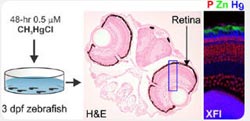The eyes have it

A cross section of a zebrafish eye shows the localization of mercury in the outer segments of photoreceptor cells. <br><br>Reference: Malgorzata Korbas, Barry Lai, Stefan Vogt, Sophie-Charlotte Gleber, Chithra Karunakaran, Ingrid J. Pickering, Patrick H. Krone, and Graham N. George. "Methylmercury Targets Photoreceptor Outer Segments." ACS Chemical Biology (2013). <br>DOI: 10.1021/cb4004805<br>Link: http://pubs.acs.org/doi/abs/10.1021/cb4004805<br>
More than one billion people worldwide rely on fish as an important source of animal protein, states the United Nations Food and Agriculture Organization. And while fish provide slightly over 7 per cent of animal protein in North America, in Asia they represent about 23 per cent of consumption.
Humans consume low levels of methylmercury by eating fish and seafood. Methylmercury compounds specifically target the central nervous system, and among the many effects of their exposure are visual disturbances, which were previously thought to be solely due to methylmercury-induced damage to the brain visual cortex.
However, after combining powerful synchrotron X-rays and methylmercury-poisoned zebrafish larvae, scientists have found that methylmercury may also directly affect vision by accumulating in the retinal photoreceptors, i.e. the cells that respond to light in our eyes.
Dr. Gosia Korbas, BioXAS staff scientist at the Canadian Light Source (CLS), says the results of this experiment show quite clearly that methylmercury localizes in the part of the photoreceptor cell called the outer segment, where the visual pigments that absorb light reside.
“There are many reports of people affected by methylmercury claiming a constricted field of vision or abnormal colour vision,” said Korbas. “Now we know that one of the reasons for their symptoms may be that methylmercury directly targets photoreceptors in the retina.”
Korbas and the team of researchers from the University of Saskatchewan including Profs. Graham George, Patrick Krone and Ingrid Pickering conducted their experiments using three X-ray fluorescence imaging beamlines (2-ID-D, 2-ID-E and 20-ID-B) at the Advanced Photon Source, Argonne National Laboratory near Chicago, US, as well as the scanning X-ray transmission beamline (STXM) at the Canadian Light Source in Saskatoon, Canada.
After exposing zebrafish larvae to methylmercury chloride in water, the team was able to obtain high-resolution maps of elemental distributions, and pinpoint the localization of mercury in the outer segments of photoreceptor cells in both the retina and pineal gland of zebrafish specimens. The results of the research were published in ACS Chemical Biology under the title “Methylmercury Targets Photoreceptor Outer Segments”.
Korbas said zebrafish are an excellent model for investigating the mechanisms of heavy metal toxicity in developing vertebrates. One of the reasons for that is their high degree of correlation with mammals. Recent studies have demonstrated that about 70 per cent of protein-coding human genes have their counterparts in zebrafish, and 84 per cent of genes linked to human diseases can be found in zebrafish.
“Researchers are studying the potential effects of low level chronic exposure to methylmercury, which is of global concern due to methylmercury presence in fish, but the message that I want to get across is that such exposures may negatively affect vision. Our study clearly shows that we need more research into the direct effects of methylmercury on the eye,” Korbas concluded.
Acknowledgments: This work was supported by the Canadian Institutes of Health Research, the Saskatchewan Health Research Foundation and the Natural Sciences and Engineering Research Council of Canada.
About the CLS:
The Canadian Light Source is Canada’s national centre for synchrotron research and a global centre of excellence in synchrotron science and its applications. Located on the University of Saskatchewan campus in Saskatoon, the CLS has hosted 1,700 researchers from academic institutions, government, and industry from 10 provinces and territories; delivered over 26,000 experimental shifts; received over 6,600 user visits; and provided a scientific service critical in over 1,000 scientific publications, since beginning operations in 2005.
CLS operations are funded by Canada Foundation for Innovation, Natural Sciences and Engineering Research Council, Western Economic Diversification Canada, National Research Council of Canada, Canadian Institutes of Health Research, the Government of Saskatchewan and the University of Saskatchewan.
Synchrotrons work by accelerating electrons in a tube at nearly the speed of light using powerful magnets and radio frequency waves. By manipulating the electrons, scientists can select different forms of very bright light using a spectrum of X-ray, infrared, and ultraviolet light to conduct experiments.
Synchrotrons are used to probe the structure of matter and analyze a host of physical, chemical, geological and biological processes. Information obtained by scientists can be used to help design new drugs, examine the structure of surfaces in order to develop more effective motor oils, build more powerful computer chips, develop new materials for safer medical implants, and help clean-up mining wastes, to name a few applications.
Media Contact
More Information:
http://www.lightsource.caAll latest news from the category: Life Sciences and Chemistry
Articles and reports from the Life Sciences and chemistry area deal with applied and basic research into modern biology, chemistry and human medicine.
Valuable information can be found on a range of life sciences fields including bacteriology, biochemistry, bionics, bioinformatics, biophysics, biotechnology, genetics, geobotany, human biology, marine biology, microbiology, molecular biology, cellular biology, zoology, bioinorganic chemistry, microchemistry and environmental chemistry.
Newest articles

Silicon Carbide Innovation Alliance to drive industrial-scale semiconductor work
Known for its ability to withstand extreme environments and high voltages, silicon carbide (SiC) is a semiconducting material made up of silicon and carbon atoms arranged into crystals that is…

New SPECT/CT technique shows impressive biomarker identification
…offers increased access for prostate cancer patients. A novel SPECT/CT acquisition method can accurately detect radiopharmaceutical biodistribution in a convenient manner for prostate cancer patients, opening the door for more…

How 3D printers can give robots a soft touch
Soft skin coverings and touch sensors have emerged as a promising feature for robots that are both safer and more intuitive for human interaction, but they are expensive and difficult…





















